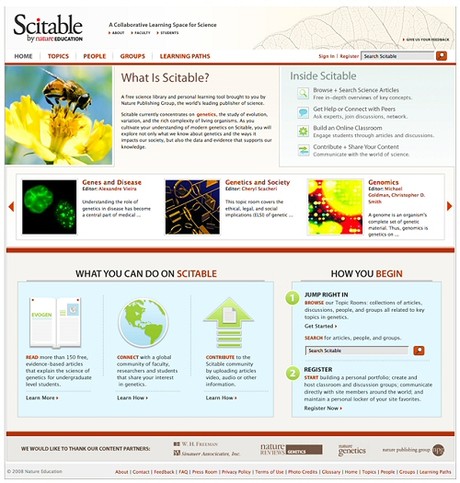Nature Reinvents Textbooks
Scitable: A NextGen Ecosystem for Learning & Teaching Science
One way to design a better mousetrap is to find an industry that is out of touch with its real customers and reinvent it. That’s what Nature Education set out to do when they designed and launched Scitable in 2009. Scitable is an online resource for students studying genetics that is designed to replace today’s science textbooks.
NETTING IT OUT
Scitable (http://www.nature.com/scitable) is a 21st century online learning resource about genetics for students and faculty. It's provided for free by Nature Education. The content is expert-sourced; not crowd-sourced. Yet, there's plenty of user-generated educational content.
Customers are faculty and college students and teachers and high school students. Students can follow their own "learning paths." Faculty can build online classrooms to leverage Scitable's content.
Scitable is Nature Education's attempt to replace traditional scientific textbooks with a new way of engaging students as well as a new business model. Students look online for resources and information. So, instead of having students pay $150 for a definitive science textbook, why not have educational institutions pay for a content- and expert-rich learning community? Why not have sponsors, who want to hire these students, help foot the bill? Scitable is already exceeding Nature's expectations in its first year of a two-year trial and a ten-year strategic plan.
I interviewed Vikram Savkar, the SVP & Publishing Director at Nature Education, who led the innovation team at Nature to create and launch Scitable. In this first part of our case study, we describe what the Nature Education team set out to accomplish, what they built, and how customers are using it. In our second installment, we will describe how they built Scitable and what they learned.
Scitable
© 2009 Nature Education
THE QUEST: BLOW UP AND REINVENT THE TEXTBOOK PUBLISHING MODEL
Vikram Savkar was a publishing revolutionary with a history of product innovations looking for an opportunity to implement a bolder, disruptive strategy than was possible at the traditional players. "I started out in the textbook publishing industry. We created custom publishing solutions. This seems like a fantastic new direction for the industry, but every custom book cannibalized the print text book. At my former employer, we had a billion dollar textbook base. We needed to grow revenues three percent per year. The traditional textbook was still in the driver's seat of that strategy; yet it was clear that this traditional model has a limited shelf-life."
Vikram wasn't satisfied with making incremental improvements to the textbook publishing model. He wanted to challenge the underlying assumptions on which that model was based:
- Professors and teachers "adopt' one or two textbooks for their courses.
- Students buy these books for prices ranging up to $150 each.
- Each textbook is written by one or two experts (often professors) under contract to a publishing company, in a process that takes at least three years.
- Professors/teachers assign chapters to students to read and discuss for each class.
So, when Nature Publishing Group (NPG) reached out to Vikram Savkar in 2007 and offered him an opportunity to create a new educational division to reinvent scientific textbook publishing, he jumped at the chance.
Nature Publishing Group (NPG) is best-known for its flagship Nature international weekly journal. NPG publishes 30 journals, Scientific American magazine, and many online databases across the life, physical, and applied sciences and, most recently, clinical medicine. The Nature.com Web site is one of the most popular scholarly sites on the Internet, serving almost 12 million visitors a month. NPG is a subsidiary of MacMillan Publishers, Ltd., which is, in turn, owned by a German-based, family-run company, Holtzbrinck.
CAN WE IMPROVE SCIENCE EDUCATION?
"If we want kids to care about science, something very different needs to happen. We know that students bail out of science at an alarming rate. 47 percent of students who start out of science don't graduate in science1," Vikram pointed out.
Vikram felt that students' needs and behaviors had changed and that traditional textbook publishing companies weren't going to able to move radically enough to shape the offerings that would replace the current ones. "I saw an underlying migration of taste combined with slow progress on traditional products. That creates an opportunity."
How Do Students Want to Interact with Information?
At his last company, Vikram had spent a lot of time talking with customers—both students and professors/teachers. "We had a long list of things cued up that I knew from talking to customers...
***Endnote***
1) Xianglei Chen, MPR Associates, Inc. and Thomas Weko, Project Officer National Center for Education Statistics, “Students Who Study Science, Technology, Engineering, and Mathematics (STEM) in Postsecondary Education,” Stats in Brief, U.S. Department of Education NCES 2009-161, Institute of Education Sciences, National Center for Education Statistics, July 2009.
***Endnote***
Sign in to download the full article
0 comments
Be the first one to comment.




